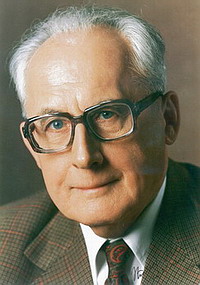1977 Rudolf Hell
Inventor and Technologist / Kiel, Germany

"Rudolf Hell is the Edison of the graphic arts industry", as stated in the laudatory speech by Hermann Zapf in 1997. The inventor Rudolf Hell was born in Eggmühl/Oberpfalz in 1901 and died in 2002 in Kiel. At a young age, Hell had a great fondness for the natural sciences and so he decided to study electrical engineering at the Technical University in Munich. Two years after graduating as an engineer, in 1925 he introduced a photoelectric image dissector tube for television as an assistant of Max Scheckmann. It was followed by a television system with mechanical image splitter and his doctorate about a direct reading radiogoniometer for aviation.
In 1929, Hell founded his own company in Neubabelsberg and introduced the Hellschreiber he had invented. His company was partially destroyed in World War II, so he had to start again in 1947 in Kiel-Dietrichsdorf. In the following years, he worked intensively on phototelegraphy and developed appropriate equipment for the post office, press, police and weather services. With the invention of the Klischograph in 1951, Hell finally initiated a new era of printing technology. He also revolutionized the typeset with the presentation of the electronic typeset with digital storage in 1965. In total, Hell registered 131 patents in his life.
In 1977, in addition to other honors, the inventor received the Gutenberg Prize of the City of Mainz and the International Gutenberg Society for the principle of breaking down letters, characters and figures into tiny individual elements of electronic impulses.